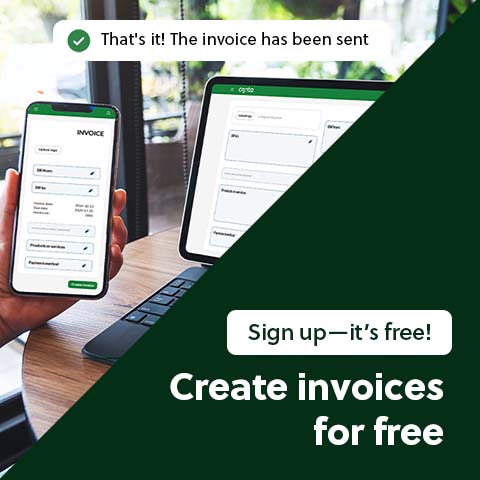While budgeting can be helpful in your personal life, it’s extremely important for your business. Let’s look at how to set up a budget and cover the key things you should include.
A budget is a planning document that shows how your business’ income and expenses will fluctuate over a certain period or for the duration of a project. It will show whether your business is likely to be profitable or not.
A budget is useful at many stages of running a business: when you’re starting up, when you’re getting steady projects and when you’re planning for your future.
Running a business can be difficult…
That’s why we’ve made our invoice software completely free. You can create, send and manage your invoice all in one place. Try it now and save money in your budget.
Before starting a business, it’s a good idea to set up a starting budget to identify initial expenses and how much money you need to get your business off the ground. Once your business is operational you should make an operating budget, also known as a profit budget. This budget forecasts income and expenses over a certain period, and helps you manage ongoing operations.
It’s important to tailor your budget to your needs. Budgets can be set up for various time frames—weekly, monthly, quarterly, annually, or even for multiple years. If you manage projects, you can also set up a budget per project.
Download our free template for businesses.
What should you include in a budget?
It can be difficult to find the right budget template for you. The vast majority of budgets have a time constraint, which can be either a project duration or actual dates. Beyond that, you choose what to include based on your business goals and needs.
There are many types of budgets: start-up budgets estimate what it will cost to start a business, profit and loss budgets and a liquidity budgets, which all companies should have—and if you plan to invest, you can set up an investment budget.
Before you start a business
During the start-up period, your expenses are often greater than your income, and it might take longer than you think to start earning money. That’s why it’s a good idea to use a budget to get an overview of what you need, when you need it, and what it will cost.
A start-up budget shows how much money you expect to spend starting your business, and therefore how much money you need.
What you should include will vary based on what kind of goods and services you’re going to provide. It might be a good idea to talk to others in the same industry and ask about what kind of start-up costs they had.
Pro-tip: Make a solid plan before you dive in
Are you going to start a business? In addition to a start-up budget, it’s also a good idea to set up a business plan. You can also download our free business model canvas template to help you on your way.
Items that are usually included
- Premises: Renting or purchase an office space or a store, including necessary renovation.
- Furniture: Does the office space or store need furniture?
- Means of transport: Does your company need a car?
- Office equipment: Office supplies, laptop, work phone.
- Production equipment: Necessary equipment for producing goods.
- Inventory: If you sell goods, you usually need to have an inventory in place before you start
- Tools: Necessary tools to provide services or produce goods.
- Marketing: Logo, website, domain, Facebook and other social media accounts.
Once you have a start-up budget in place, you can start your business. These are the types of company types you can choose from when starting a business.
Essential budgets: liquidity budget and profit budget
Once you’ve started your business, you should prioritize setting up a profit budget and a liquidity budget.
- A profit and loss budget outlines your planned income and expenses. By comparing expenses and income, you can estimate how much tax you’ll need to pay and whether your business is making money. A profit and loss budget usually covers a calendar year, but can also be set up for shorter periods like months or quarters.
- A liquidity budget shows your estimated cash inflows and outflows, helping you manage cash flow more effectively. In a liquidity budget, you will see if you have money to cover the costs that arise along the way and it is the easiest way to find out if your company has enough money to pay the bills each month.
By setting up these two essential budgets, you can make better financial decisions.
See also: The ultimate guide to liquidity and cash flow
Can I change my budget after it has been set up?
A budget can be changed along the way, and it’s usually necessary to make changes. Unexpected circumstances can mean that your income is much lower than you have budgeted for. Or maybe you end up earning a lot more than you thought you would.
Your budget should always be as correct as possible so that you have control over your finances and can make the right decisions for your business.
Remember to always have a buffer so that you’re prepared for unexpected costs: it’s better to have a little extra money to cover unexpected costs, rather than having to borrow more capital or cut back on other expenses.
Say goodbye to the hassle of invoicing
Conta streamlines the process, allowing you to breeze through it in under 2 minutes. Just enter customer details, product and price information, and send your professional invoice quickly and easily.
How budgeting can give you better liquidity
When you have control over your finances, it’s easier to have good liquidity. This is because you can avoid spending beyond your means. Both the profit and liquidity budget will help you improve your liquidity.
Having good liquidity is important because it means you can pay bills and cover expenses. If you have good liquidity, it’s also easier to get others to invest in your company, to hire new employees, and to sell services or products, because they’ll all see that you’re running a professional business.
Budget and accounting – how are they connected?
If you run a business, you’re likely familiar with both budgeting and accounting. While it’s not mandatory to have a budget, maintaining accurate accounts is essential.
A budget is your financial plan, outlining expected income and expenses. Accounting, on the other hand, records the actual income and expenses you’ve incurred. Simply put, the budget is your estimate for what will happen; the accounts show what actually happened.
The figures from your accounting provide a solid foundation and can help you set up or adjust your budget.
If there are discrepancies between your budget and your actual accounts, it’s a sign that you should review your priorities, targets, income, and costs. You may need to adjust the document or reconsider your spending to ensure you’re not overspending.

In conclusion: Set up a budget to get an overview
One of the first things you have to do is get an overview of what you need for your business, which costs you will have and how you’re going to make money. In the start-up phase of a business, it’s a good idea to save money where you can. You can cut cost by using free invoice software to create invoices.
A budget will increase your chances of success, and help ensure that you earn enough money to cover your expenses, and hopefully end up earning money doing what you love!





